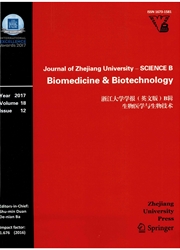

 中文摘要:
中文摘要:
为了为从中国药用的植物屏蔽人的 β 2-adrenoceptor 的收缩筋开发一个模型,提取,我们基于普通 G 联合蛋白质的受体(GPCR ) 使用了基于房间的功能的试金规定机制和使动摇的提高的绿色荧光灯的蛋白质(d 2 EGFP ) 记者基因技术。积极房间克隆被即时聚合酶链反应(PCR ) 和成像分析证实。为了估计这的价值,当模特儿,我们屏蔽了 -fractionated 从中国药用的植物的乙醇摘录取样的超过 2000 高效液体层析(HPLC ) 。六部分(从人参属孤立日本我们, Veratrum nigrum , Phellodendron amurense , Fructus Aurantii Immaturus , Chaenomeles speciosa ,和 Dictamnus dasycarpus )积极记者基因表示上的显示出的重要效果,哪个中的三个(从 Phellodendron 孤立 amurense , Fructus Aurantii Immaturus ,并且 Chaenomeles speciosa )为进一步的集中反应分析和一半被选择最大的有效集中( EC 1/2 最大)价值分别地是 4.2 , 2.7 ,和 4.8 μg/ml 。因此,这记者基因试金对屏蔽 β 2-adrenoceptor 收缩筋合适。结果建议六篇草药的摘录是 β 2-adrenoceptor 的可能的收缩筋。
 英文摘要:
英文摘要:
In order to develop a model for screening the agonists of human β2-adrenoceptor from Chinese medicinal herbs extracts, we used a cell-based functional assay based on a common G protein-coupled receptor (GPCR) regulation mechanism and destabilized enhanced green fluorescent protein (d2EGFP) reporter gene technique. The positive cell clone was confirmed by real-time polymerase chain reaction (PCR) and imaging analysis. To assess the value of this model, we screened over 2000 high performance liquid chromatography (HPLC)-fractionated samples from the ethanol extracts of Chinese medicinal herbs. Six fractions (isolated from Panax japonicus, Veratrum nigrum, Phellodendron amurense, Fructus Aurantii lmmaturus, Chaenomeles speciosa, and Dictamnus dasycarpus) showed significant effects on active reporter gene expression, three of which (isolated from Phellodendron amurense, Fructus Aurantii lmmaturus, and Chaenomeles speciosa) were selected for further concentration response analysis and the half maximal effective concentration (EC1/2 max) values were 4.2, 2.7, and 4.8 μg/ml, respectively. Therefore, this reporter gene assay was suitable for screening β2-adrenoceptor agonists. The results suggest that the six herbal extracts are the possible agonists of β2-adrenoceptor.
 同期刊论文项目
同期刊论文项目
 同项目期刊论文
同项目期刊论文
 期刊信息
期刊信息
